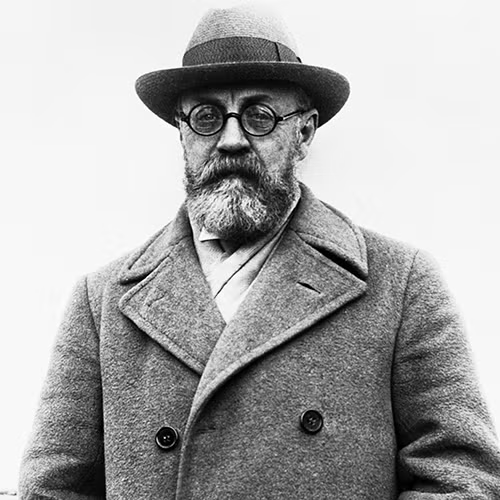
Table of Contents
Who Was Henri Matisse?
Henri Matisse was a pioneering artist whose career spanned over six decades, making him one of the most influential figures in 20th-century art. Known for his mastery across various mediums—including painting, sculpture, and printmaking—Matisse’s work is celebrated for its innovative use of vivid color and exaggerated forms, which conveyed deep emotional expression. Although his subjects—such as nudes, portraits, landscapes, and interior scenes—were conventional, his bold artistic approach broke new ground and cemented his legacy as a revolutionary force in modern art.
Early Life and Training
Henri Matisse was born on December 31, 1869, in Bohain-en-Vermandois, a small industrial town in northern France. Raised in a family involved in the grain business, Matisse initially pursued a legal career. From 1887 to 1889, he studied law in Paris and later worked as a legal clerk. However, while recovering from an illness at the age of 21, Matisse discovered a passion for painting. This newfound interest became his life’s calling.
In 1891, Matisse returned to Paris to formally train as an artist. He studied under renowned instructors at prestigious institutions like the Académie Julian and the École des Beaux-Arts, where he learned the “academic method”—working from live models and copying classical artworks. While in Paris, he was also exposed to the progressive works of Post-Impressionist masters like Paul Cézanne and Vincent van Gogh, which would deeply influence his style.
Matisse began exhibiting his work in major Parisian art shows during the mid-1890s, including the esteemed Salon de la Société Nationale des Beaux-Arts, where he gained positive recognition. He traveled extensively, visiting London and Corsica, and in 1898, he married Amélie Parayre, with whom he had three children. This period marked the beginning of Matisse’s long and storied career, during which he would push the boundaries of artistic expression and leave an indelible mark on the world of modern art.
Breakthrough Period
By the early 20th century, Henri Matisse came under the influence of progressive artists Georges Seurat and Paul Signac, who painted in the Pointillist style using small dots of color rather than traditional brushstrokes. Matisse, abandoning the official Salon, began exhibiting his work at the more avant-garde Salon des Indépendants in 1901. His first solo exhibition followed in 1904 at the gallery of Ambroise Vollard. That same period marked a significant creative breakthrough for Matisse. A trip to Saint-Tropez in 1904 inspired the radiant painting Luxe, Calme et Volupté (1904–05). The following summer, he produced two major works—Open Window and Woman with a Hat—in the village of Collioure, which were later exhibited at the 1905 Salon d’Automne. The bold, expressive use of color and form in these works prompted a contemporary critic to label Matisse and his contemporaries as “fauves” or “wild beasts,” a term that would define the Fauvist movement.
Matisse embraced Fauvism, prioritizing emotional intensity through bold lines, dynamic brushwork, and vivid, unmodulated color. One of his defining works from this period, The Joy of Life (1906), exemplifies his focus on mood over realistic representation, with its flowing forms and lush color palette. Throughout the first decade of the century, he also explored sculpture and drawing, using these mediums to distill his forms to their most essential elements.
Success and Fame
Having solidified his unique style, Matisse experienced growing success. He traveled extensively, drawing inspiration from Italy, Spain, Germany, and North Africa. With his increased recognition, he acquired a large studio in the suburbs of Paris and signed a contract with the prestigious Galerie Bernheim-Jeune. His work was sought by influential collectors, including Gertrude Stein and Russian industrialist Sergei Shchukin, who commissioned Matisse’s iconic works Dance I and Music.
In the 1910s and 1920s, Matisse continued to explore his signature use of saturated colors, flattened space, and simplified forms. Pieces like The Piano Lesson (1916) engaged with Cubist geometry, reflecting his ongoing dialogue with Picasso, his lifelong artistic rival. Despite his radical approach, Matisse often returned to traditional themes, painting portraits, studio scenes, and domestic interiors. Notable works from this period include The Red Studio (1911), which exemplified his mastery of spatial compression and color.
From 1917, Matisse began spending winters on the Mediterranean, and by 1921 he had settled in Nice. During the following decade, his work largely focused on female nudes, set against richly patterned and warmly lit studio interiors. He also became deeply involved in printmaking, further broadening his artistic output. His importance in modern art was solidified with the publication of the first scholarly book about his work in 1920.
Later Years and Death
In his later career, Matisse continued to receive significant commissions, including a mural for Dr. Albert Barnes’ gallery in Pennsylvania, Dance II (1931–33). He also contributed illustrations for limited-edition books of poetry. Despite undergoing major surgery in 1941, which left him often bedridden, Matisse continued creating. From his bed, he adapted his working methods, using long poles to draw or paint. His late work remained vibrant and innovative, exemplified by his 1947 book Jazz, which paired his musings on life and art with colorful paper cutouts. This technique culminated in several major works, including Swimming Pool (1952), which featured bold, expressive human forms cut from bright blue paper.
One of Matisse’s final masterpieces was the complete design of the Chapel of the Rosary in Vence (1948–51). He created stained-glass windows, murals, and even the vestments for the priests, demonstrating his holistic approach to art.
Henri Matisse passed away on November 3, 1954, in Nice at the age of 84. He was laid to rest in Cimiez. Today, Matisse is celebrated as one of the most innovative and influential artists of the 20th century, known for his revolutionary use of color and form that forever changed modern art.
